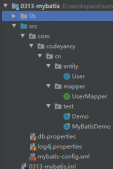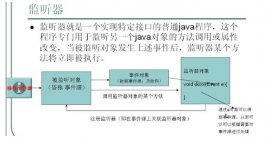1、背景
我们谈到Spring的时候一定会提到IOC容器、DI依赖注入,Spring通过将一个个类标注为Bean的方法注入到IOC容器中,达到了控制反转的效果。那么我们刚开始接触Bean的时候,一定是使用xml文件,一个一个的注入,就例如下面这样。
|
1
|
<bean id="bean" class="com.xxx.xxx.Bean" /> |
我们的项目一般很大的话,就需要成千上百个Bean去使用,这样写起来就很繁琐。那么Spring就帮我们实现了一种通过注解来实现注入的方法。只需要在你需要注入的类前面加上相应的注解,Spring就会帮助我们扫描到他们去实现注入。
xml扫描包的方式
|
1
|
<context:component-scan base-package="com.xxx"/> |
2、通过注解注入的一般形式
一般情况下,注入Bean有一个最直白,最易懂的方式去实现注入,下面废话先不多说,先贴代码。
2.1、Bean类
|
1
2
|
public class MyBean{} |
2.2、Configuration类
|
1
2
3
4
5
6
7
8
9
|
//创建一个class配置文件@Configurationpublic class MyConfiguration{//将一个Bean交由Spring进行管理 @Bean public MyBean myBean(){ return new MyBean(); }} |
2.3、Test类
与xml有一点不同,这里在Test中,实例化的不再是ClassPathXmlApplicationContext,而是获取的AnnotationConfigApplicationContext实例。
|
1
2
3
|
ApplicationContext context = new AnnotationConfigApplicationContext(MyConfiguration.class);MyBean myBean = cotext.getBean("myBean",MyBean.class);System.out.println("myBean = " + myBean); |
上面的代码中MyBean也就是我们需要Spring去管理的一个Bean,他只是一个简单的类。而MyConfiguration中,我们首先用@Configuration注解去标记了该类,这样标明该类是一个Spring的一个配置类,在加载配置的时候会去加载他。
在MyConfiguration中我们可以看到有一个方法返回的是一个MyBean的实例,并且该方法上标注着@Bean的注解,标明这是一个注入Bean的方法,会将下面的返回的Bean注入IOC。
3、通过构造方法注入Bean
我们在生成一个Bean实例的时候,可以使用Bean的构造方法将Bean实现注入。直接看代码
3.1、Bean类
|
1
2
3
4
5
6
7
8
9
10
11
12
13
14
|
@Componentpublic class MyBeanConstructor { private AnotherBean anotherBeanConstructor; @Autowired public MyBeanConstructor(AnotherBean anotherBeanConstructor){ this.anotherBeanConstructor = anotherBeanConstructor; } @Override public String toString() { return "MyBean{" + "anotherBeanConstructor=" + anotherBeanConstructor + '}'; }} |
3.2、AnotherBean类
|
1
2
3
|
@Component(value="Bean的id,默认为类名小驼峰")public class AnotherBean {} |
3.3、Configuration类
|
1
2
3
4
|
@Configuration@ComponentScan("com.company.annotationbean")public class MyConfiguration{} |
这里我们可以发现,和一般方式注入的代码不一样了,我们来看看新的注解都是什么意思:
@AutoWired
简单粗暴,直接翻译过来的意思就是自动装配:wrench:,还不理解为什么叫自动装配:wrench:?看了下一个注解的解释你就知道了。若是在这里注入的时候指定一个Bean的id就要使用@Qualifier注解
@Component(默认单例模式)
什么??这翻译过来是零件,怎么感觉像是修汽车??是的,Spring管理Bean的方法就是修汽车的方式。我们在需要将一个类变成一个Bean被Spring可以注入的时候加上注解零件@Conmonent,那么我们就可以在加载Bean的时候把他像零件一样装配:wrench:到这个IOC汽车上了
在这里我们还有几个其他的注解也可以实现这个功能,也就是细化的@Component:
@Controller 标注在Controller层
@Service 标注在Service层
@Repository 标注在dao层
@ComponentScan("")
还是翻译,零件扫描,我们去看看括号里的“零件仓库”里面,哪些“零件”(类)需要被装载,Spring就会去扫描这个包,将里面所有标注了@Component的类进行注入。
这里的通过构造方法进行注入就很好理解了,我们在装配MyBean这个零件的时候,突然发现他必须在AnotherBean的基础上才能安装到IOC里面,那么我们就在每次装配MyBean的时候自动装配:wrench:一个AnotherBean进去。举个:chestnut:吧:
还是以汽车为例,我们在踩油门出发之前,是不是必须发车??这里的AutoWired的内容就像发车,你不发车,这个油门你踩断都没有用,他都不会走。
4、通过set方法注入Bean
我们可以在一个属性的set方法中去将Bean实现注入,看代码吧
4.1、MyBean类
|
1
2
3
4
5
6
7
8
9
10
11
12
13
14
|
@Componentpublic class MyBeanSet { private AnotherBean anotherBeanSet; @Autowired public void setAnotherBeanSet(AnotherBean anotherBeanSet) { this.anotherBeanSet = anotherBeanSet; } @Override public String toString() { return "MyBeanSet{" + "anotherBeanSet=" + anotherBeanSet + '}'; }} |
4.2、Configuration类 和 Test类
同上一个,就不贴了
这里我们发现在setter方法上我们有一个@AutoWired,与上面不同的是,我们不会在实例化该类时就自动装配:wrench:这个对象,而是在显式调用setter的时候去装配。
5、通过属性去注入Bean
我们前面两种注入的方式诸如时间不同,并且代码较多,若是通过属性,即就是
|
1
2
3
4
5
6
7
8
9
10
11
|
@Componentpublic class MyBeanProperty { @Autowired private AnotherBean anotherBeanProperty; @Override public String toString() { return "MyBeanProperty{" + "anotherBeanProperty=" + anotherBeanProperty + '}'; }} |
这里我们可以看到我们这个类中需要使用AnotherBean这个实例对象,我们可以通过@AutoWired去自动装配它。
6、通过List注入Bean
6.1、MyBeanList类
|
1
2
3
4
5
6
7
8
9
10
11
|
@Componentpublic class MyBeanList { private List<String> stringList; @Autowired public void setStringList(List<String> stringList) { this.stringList = stringList; } public List<String> getStringList() { return stringList; }} |
6.2、MyConfiguration类
|
1
2
3
4
5
6
7
8
9
10
11
|
@Configuration@ComponentScan("annoBean.annotationbean")public class MyConfiguration { @Bean public List<String> stringList(){ List<String> stringList = new ArrayList<String>(); stringList.add("List-1"); stringList.add("List-2"); return stringList; }} |
这里我们将MyBeanList进行了注入,对List中的元素会逐一注入。下面介绍另一种方式注入List
6.3、MyConfiguration类
|
1
2
3
4
5
6
7
8
9
10
11
|
@Bean//通过该注解设定Bean注入的优先级,不一定连续数字@Order(34)public String string1(){ return "String-1";}@Bean@Order(14)public String string2(){ return "String-2";} |
注入与List中泛型一样的类型,会自动去匹配类型,及时这里没有任何List的感觉,只是String的类型,但他会去通过List的Bean的方式去注入。
第二种方式的优先级高于第一种,当两个都存在的时候,若要强制去使用第一种方式,则要去指定Bean的id即可
7、通过Map去注入Bean
|
1
2
3
4
5
6
7
8
9
10
11
12
13
14
15
16
17
18
19
20
21
22
23
24
25
26
|
@Componentpublic class MyBeanMap { private Map<String,Integer> integerMap; public Map<String, Integer> getIntegerMap() { return integerMap; } @Autowired public void setIntegerMap(Map<String, Integer> integerMap) { this.integerMap = integerMap; }}@Bean public Map<String,Integer> integerMap(){ Map<String,Integer> integerMap = new HashMap<String, Integer>(); integerMap.put("map-1",1); integerMap.put("map-2",2); return integerMap; } @Bean public Integer integer1(){ return 1; } @Bean public Integer integer2(){ return 2; } |
同样这里也具有两种方式去注入Map类型Bean,且第二种的优先值高于第一种
以上就是Bean通过注解注入的几种方式,大家可以对比着xml注入的方式去看。希望大家以后多多支持服务器之家!
原文链接:https://blog.csdn.net/qq_34272760/article/details/120987792

















